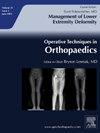Epidemiology: Prevalence, Incidence, and Implications of Ramp Lesions
IF 0.3
Q4 ORTHOPEDICS
引用次数: 0
Abstract
Meniscal ramp lesions are defined as longitudinal peripheral tears in the medial meniscus where the meniscocapsular and meniscotibial ligaments connect to the posterior horn. Meniscal ramp lesions are commonly associated with ACL tears but can easily be overlooked due to low sensitivity of diagnosis via MRI and their location posterior to the posterior horn of the medial meniscus. Left untreated, ramp lesions can lead to pain, decreased knee function, altered knee kinematics, and a decreased quality of life. Due to the impact meniscal ramp lesions can have on a patients' overall function, it is recommended to have a high index of suspicion for meniscal ramp lesions. Also, it is imperative to establish and utilize a posteromedial portal to directly probe the posterior horn of the medial meniscus when investigating the presence and stability of meniscal ramp lesions. Treatment options for meniscal ramp lesions can be non-operative, biological treatment, or meniscal repair with suture fixation. Non-operative management can be considered for stable lesions, while different operative techniques including inside-out, and all-inside repair have been described for meniscal ramp lesions requiring surgical fixation. Overall, Meniscus ramp lesions show good healing potential, as an excellent healing rate of 89% after meniscus ramp lesion repair has been reported and biological treatment such as trephination or rasping has also been shown to have positive results, whether done in isolation for more stable lesions or done in conjunction with suture fixation.
流行病学:Ramp病变的流行、发病率和影响
半月板斜坡病变定义为内侧半月板纵向外周撕裂,半月板囊和半月板胫韧带连接后角。半月板斜坡病变通常与前交叉韧带撕裂有关,但由于MRI诊断敏感性低且其位置位于内侧半月板后角后方,因此很容易被忽视。如果不及时治疗,斜坡病变可导致疼痛、膝关节功能下降、膝关节运动改变和生活质量下降。由于半月板斜坡病变对患者整体功能的影响,建议对半月板斜坡病变有高度的怀疑指数。此外,在调查半月板斜坡病变的存在和稳定性时,必须建立和利用后内侧门静脉直接探测内侧半月板后角。半月板斜坡病变的治疗选择可以是非手术、生物治疗或半月板缝合固定修复。对于稳定的病变,可以考虑非手术治疗,而对于需要手术固定的半月板斜坡病变,已经描述了不同的手术技术,包括由内而外和全内修复。总体而言,半月板斜坡病变显示出良好的愈合潜力,据报道,半月板斜坡病变修复后的良好治愈率为89%,生物治疗(如穿孔术或刮刀术)也显示出积极的结果,无论是单独进行更稳定的病变还是与缝合固定联合进行。
本文章由计算机程序翻译,如有差异,请以英文原文为准。
求助全文
约1分钟内获得全文
求助全文
来源期刊

Operative Techniques in Orthopaedics
ORTHOPEDICS-
CiteScore
0.40
自引率
0.00%
发文量
40
审稿时长
83 days
期刊介绍:
Operative Techniques in Orthopaedics is an innovative, richly illustrated resource that keeps practitioners informed of significant advances in all areas of surgical management. Each issue of this atlas-style journal explores a single topic, often offering alternate approaches to the same procedure. Its current, definitive information keeps readers in the forefront of their specialty.
 求助内容:
求助内容: 应助结果提醒方式:
应助结果提醒方式:


